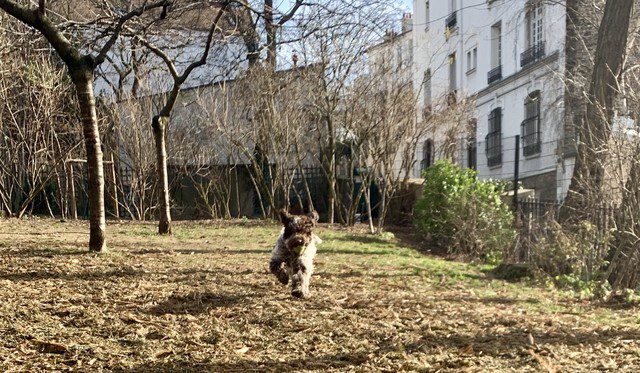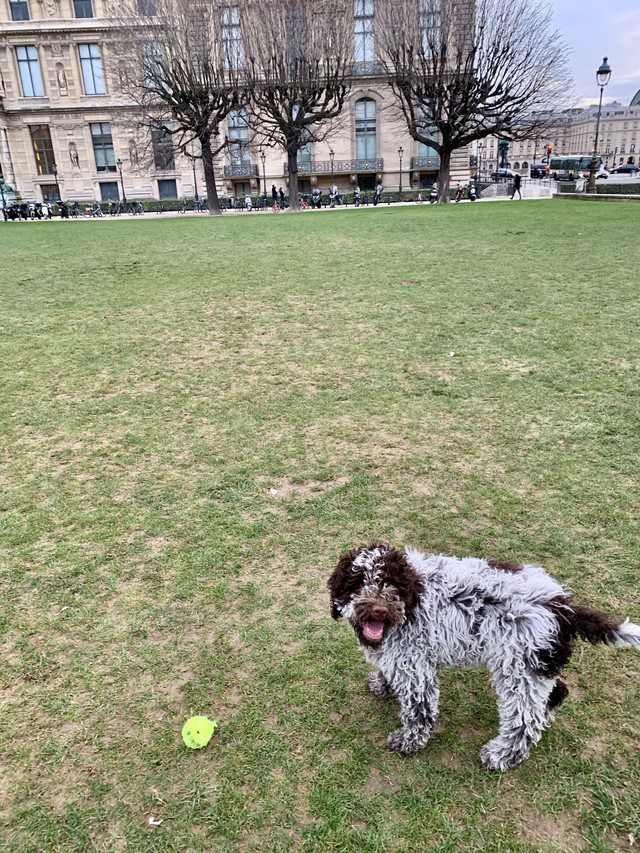How to Travel to Paris With Your Pet
Originally published by Shannen on February 2019 and updated by Vanessa on May 2023.

Want to bring your pet with you on your next visit to the City of Love? Here’s how. Photo Sourced from Unsplash
Traveling with a pet to a foreign country is almost never an easy task. Luckily, bringing your cat or dog to France is actually less complicated than other countries. In typical French bureaucratic style there are quite a few requirements, but if you tick all the boxes before setting off, your experience should be relatively hassle-free.
Each airline has a different set of criteria surrounding prohibited breeds, size and weight limits, and whether your pet will need to be checked or carried on the plane as hand luggage. Additionally, your country of origin will make a huge difference when it comes to traveling with your cat or dog to Paris. Countries in the EU and Schengen Area member countries will have an easier time bringing a pet to Paris. However, those of us outside the EU will have to provide proof of immunizations, a pet passport, as well as other requirements.
And then there are the things you need to consider once in Paris. Known for being a dog-centric city, you can expect to see four-legged friends in cafes, banks, even on the metro.
Read also; Dog Friendly Spots in Paris
But one place you won’t find Parisian dogs? In 413 out of 490 green spaces throughout the city.
That’s right, the city loves to have dogs everywhere… other than parks. However, that doesn’t mean you shouldn’t bring your dog to Paris but you will have to get more strategic about where you stay and finding suitable places for a petite promenade.
This guide is based on my own personal experiences of traveling with my dog to Paris. It is not meant to be legal advice, and I suggest doing additional research as well as consulting with your veterinarian before booking a flight. I will also review some of the best dog-walking areas around the city and where to stay to ensure your pooch enjoys the City of Lights just as much as you do.

Sourced from Unsplash
As I mentioned above, bringing your cat or dog to Paris isn’t necessarily a difficult process, but there are a number of steps and you will have to follow them to a T if you want to get past the customs officers.
Note: depending on your situation there may be additional steps required, other than those listed below. For example, if your dog is not already microchipped and/or does not have a valid rabies vaccination you will have a few additional steps.
Read also; Best Pet Stores in Paris
Step One: Research the Airline

Traveling with your dog to Paris means wine, cheese, and puppies
Different airlines have different criteria for what pets can fly and how. Typically, if your pet’s weight, including their approved carrier, exceeds 20 pounds (9 kgs), they will have to fly in the cargo hold.
Check what airlines fly to Paris from your point of departure and read about their requirements. Following some stranger animals (emotional support peacock, anyone?) being classified as “Emotional Support Animals” in order to fly in the cabin, airlines are cracking down on pets in the main cabin in general. And rules may be even stricter for long-haul flights.
Additionally, there are a few major airlines in The States that will not fly dogs in the cargo due to liability concerns. They include:
- Virgin America
- Jet Blue
- US Airways
Flying in the cabin is typically far less stressful if your pet fits the size requirements and is crate trained. If you’re absolutely set on bringing your pet and do not fit these requirements, you have to understand the liability the airline will take if something goes wrong while your dog is in the cargo hold. Be sure to familiarize yourself with the airline’s handling procedures, and read reviews from other travelers. The most important thing is that your pet is safe and well cared for while on the flight.
Another thing to note about flying with your pet is that there are additional fees. Most airlines flying from the US to France charge a standard $200 to bring your pet on the flight as hand luggage. If you have to check your dog, this price can be greatly more. Your pet often times will also often count as your first piece of checked luggage, so if you plan to bring a checked bag, you will have to pay additional fees for that as well.
Before booking, check this website for a comprehensive database of airlines and their pet requirements. And of course, follow up with the airline directly to confirm.
Read also; The Best Cat Cafés of Paris
Step Two: Check Country Requirements
Every country has a different set of requirements for entering with a pet, and this depends on your point of departure as well. To enter France from the US your pet must:
- Be at least 12 weeks old
- Have a standard ISO 11784 or annex A ISO standard 11785 microchip, or a tattoo. In case of identification with a tattoo, the tattoo must be clearly readable and applied before July 2011.
- Have a valid rabies vaccination. If it is the first rabies vaccination for your pet, you must wait 21 days between the last shot of the vaccination and departure.
- Have a health certificate (“Certificat Vétérinaire”) from your veterinarian and endorsed by the USDA (if traveling from the US). This endorsement is required for all pets, except those issued by military veterinarians for dogs, cats, and ferrets.
Note: while these guidelines are specific to arriving from the US, they look pretty similar to the requirements for entering from any non-EU country. For more information, this post lists the most common requirements for bringing an animal from any third countries (non-EU).
The health certificate is likely the most tricky part of bringing an animal to France. It must be the correct form– if you are traveling on the same plane as your pet, make sure you have the form that says “for non-commercial movements.” It must be filled out and signed by a USDA-certified veterinarian and endorsed by the USDA.
Step Three: Obtain the Health Certificate (if traveling from the US)
As I stated above, this part of the process can get pretty tricky, and there’s a lot of ways it can go astray if you’re not careful. To provide some clarity, I’ve broken down this step into three parts:
- Download the correct form for France from the USDA’s website. Consider calling your local USDA office to check for any recent changes to the form.
- Call your usual veterinarian to ask if he/she is USDA-certified. If not, contact your state’s NVAP Coordinator for a list of accredited veterinarians near you.
- Make sure your vet fills out and signs the form in blue ink, not black (a small detail, but trust me, they care).
- Either make an appointment and bring the completed form to your state’s USDA office for endorsement, or you can send the form to the office by overnight service. If you choose the latter, make sure to enclose a return pre-address and prepaid envelope.
The veterinary exam you need in order to get the health certificate has to happen within 10 days of arriving in France. To account for any flight delays or other unforeseen problems, be sure to schedule your appointment close enough to your departure so you have some buffer time built in. But remember you must also get this certificate endorsed by the USDA. So, either schedule your USDA appointment for the day after the veterinary exam or mail it overnight and cross your fingers it all gets back to you in time.
Step Four: Find a Suitable Place to Stay in Paris
As I mentioned, there aren’t so many dog-friendly green spaces around the city where pets can run off-leash. The parks and forest where pets can really be set free are either on the East or West sides of Paris, with a few smaller options scattered throughout the city.
If you don’t want to spend much of your vacation on public transport trying to reach these few and far between locations, I suggest strategically choosing your lodging so that the journey to reach a park every day will not be too long.
For Dogs with High Energy

There aren’t so many options for dogs with high-energy in Paris
The best options for dogs that need a lot of exercise are in the areas near the Bois de Boulogne on the West or Bois de Vincennes on the East. To easily reach the Bois de Boulogne, I suggest staying in the 16th arrondissement– this includes areas near Place du Trocadero (right by the Eiffel Tour). You can also opt to stay just outside of Paris in Saint-Cloud or Boulogne-Billancourt. Both are charming suburbs that are serviced by public transportation and close to the Bois.
If you wish to stay on the other side of Paris near Bois de Vincennes, you can either find a place near Bastille and take the Line 1 to Vincenne, near the Coulée Verte or stay just outside Paris in Vincennes. The Coulée Verte is a former rail line in the 12th arrondissement that has been transformed into a long, narrow green space. The Bois de Vincennes is at the end of the walk, making this a great option for dog owners who don’t mind a long walk and want to stay in central Paris.
Other Dog-Friendly Areas in Paris

Walking Paddington in Montmartre. There’s not a lot of green space so we have to get creative sometimes.
If your dog requires less exercise, or if you’re okay with keeping him/her on a leash in parks, the 1st, 15th, 12th, 7th, and 14th arrondissements are also fairly dog-friendly. If you opt to take a walking tour of Montmartre, you’ll notice that there aren’t many green spaces in the area. While a tourist hub, only stay in Montmartre of you’re willing to cross the city for a dog walk, or get creative with where you walk your dog.
You also need to ensure that your lodging is pet-friendly. Many Airbnbs allow cats and dogs. For a list of 10 cool pet-friendly places around the city, check out this post.
Arriving in Paris
If you’ve managed to collect all of the required paperwork, survived the flight and the customs officers, and found a great dog-friendly place to stay, congratulations! Now all you have to do is enjoy your time in Paris with your best furry friend.
To ensure your pet also enjoys his/her vacation and gets proper exercise, there are a few options for daily dog-walks.
Bois de Boulogne
As mentioned above, Bois de Boulogne is a large wood on the West of Paris. It is easily reached from central Paris via the Metro Line 2. The wood is at the very end of the line at Port Dauphine. As far as off-leash time and allowing your doggo plenty of space to run, Bois de Boulogne is probably the best choice.
It also happens to be a pretty great place for a walk. Ceded to the city of Paris by Emperor Napoleon III in 1852, the Bois de Boulogne features English landscape gardens, several lakes, and a cascade.
Many Parisians take their dogs to the Bois de Boulogne, so you’ll have plenty of socialization available for your pooch.

Bois de Vincennes
Slightly larger than the Bois de Boulogne, Bois de Vincennes is the largest park in Paris. It is on the Eastern side of the city next to the Château de Vincennes and is easily reached from Paris via the Metro Line 1.
Similar to the Bois de Boulogne, Vincennes features a series of lakes, gardens, and cascades. Its large size and wooded areas are great for dogs to run for miles off-leash.
It’s also a great escape if you’re looking to get out of the city for an afternoon. In my opinion, the Bois de Vincennes feels a little more wild, like you’re further from the city than in Bois de Boulogne.
Read also; PARIS – WHAT YOU NEED TO KNOW BEFORE COMING TO PARIS

The Tuileries

Paddington enjoying a game of fetch in the dog-approved area of the Tuileries
If you’re looking for a spot to walk your dog in the middle of Paris, the Tuileries garden is likely your best best. While most of the park is off limits to dogs, there is one stretch where the Parisian pups regularly go to strut their stuff.
If you enter the gates near the entrance of the Musée de l’Orangerie, dogs can roam undisturbed on the stretch of gravel near there. The walkway eventually opens onto a grassy area in front of the pyramid entrance to the Louvre. This area is also fair game.
An insider’s tip: every morning around 11 am there’s a dog meetup at this grassy area. Everyone is welcome to attend, as long as your dog is properly-socialized with other dogs. The dogs play while owners and tourists snap pictures of the cute pups playing in front of the Louvre.
The Parc des Buttes-Chaumont
Buttes-Chaumont is also a great option for walking your dog in the city. It is situated in northeastern Paris, in the 19th arrondissement.
Buttes-Chaumont offers an impressive view of the city and lush grass for lounging or dog meetups. In most parts of the park, you are required to keep your dog on the leash, although in some spots you can get away with some off-leash time.
There’s a large grassy hill when you enter the park where dogs regularly play together. Depending on how crowded the park is, it can be a great option for your dog to release some energy by playing with other dogs. However, Butte-Chaumont generally is not great for jogging together or spending much time walking off-leash.

Parc Monceau
Parc Monceau is a beautiful park in the 8th arrondissement of Paris. It is fairly small and not particularly dog-friendly.
There is one straight-away where dogs are allowed to walk on the leash, but otherwise, you might get chased out for straying off the tiny dog path.
Monceau really is a lovely park and can be quite relaxing on a summer day. However, I find that it’s best reserved for smaller dogs that do not need a lot of exercise, and owners that are happy to walk up and down the same path many times.

Why Paris is a pet-friendly city
France is often regarded as one of the most pet-friendly countries in the world, with Paris frequently referred to as the capital of dog-friendliness. Dogs enjoy free reign in the city, and it is not uncommon to see gorgeous doggies in public venues such as restaurants, supermarkets, public transportation, and on the streets of Paris. Living in Paris with a dog is a rewarding experience because your four-legged pet is welcome practically everywhere. If you’re planning a trip to Paris with your dog or relocating to the City of Light, here’s everything you need to know about where you can take your dog.
Pet-friendly rentals in Paris
Finding pet-friendly lodging in Paris is simple; landlords are prohibited from discriminating against pet owners by law. Do you adore your dogs, consider them members of your family, and cannot imagine going on holiday in Paris without them? Not to worry, there are a lot of pet-friendly holiday apartments in Paris. Dog and cat sitters are no longer required in this city, as many vacation apartments welcome cats and dogs as family members. If you’re looking for a homestay or a nice bed and breakfast in Paris, the local proprietors will welcome your dogs. You only need to choose from Paris listings for lodgings, apartments, flats, houses, or villas to spend your vacation with your pets.
Read also; Best hotels to stay with dogs in Paris
Dog-Friendly Dining in Paris

Photo by cottonbro studio from Pexels
The near-universal acceptance of dogs in restaurants is one of the many surprises that await Americans dining in France. Most eateries (cafés, bistros, and brasseries) will allow you to bring your dog, but it is customary to inquire first. Paris’ restaurant sector is highly competitive. Owners know that if they refuse someone because they have a dog, the establishment next door will welcome them.
Public transportation in Paris with your dog

Photo by Tim Gouw from Pexels
In Paris, all public transportation is pet-friendly. Dogs are permitted on all public transportation in Paris, including the metro, subway, commuter trains, and buses. Small dogs are free to travel the Metro/RER and buses, but they must be in a carrier or on the lap of their owner. Large dogs must be leashed and muzzled and must obtain a child’s half-price ticket. Taxis in Paris have the option of accepting or refusing to transport your dog; it is a good idea to mention your dog when booking your cab.
If you’re traveling to Paris and want to know more about the city’s friendliness with pets you can contact International pet shipping. It has distinct restrictions for each country. These laws are in place to safeguard your pet and other animals, but they can appear endless and baffling. A professional pet travel firm can help you handle the hurdles of international pet shipping with ease, ensuring your pet arrives safely and stress-free. If you want to take your dog to lovely Paris, contact Petraveller for more information on pet travel to France and a free pet travel quote.
Planning a trip to Paris ? Get ready !
These are Amazon’s best-selling travel products that you may need for coming to Paris.
Bookstore
- The best travel book : Rick Steves – Paris 2023 – Learn more here
- Fodor’s Paris 2024 – Learn more here
Travel Gear
- Venture Pal Lightweight Backpack – Learn more here
- Samsonite Winfield 2 28″ Luggage – Learn more here
- Swig Savvy’s Stainless Steel Insulated Water Bottle – Learn more here
Check Amazon’s best-seller list for the most popular travel accessories. We sometimes read this list just to find out what new travel products people are buying.










